#like i know it's an otome game and the target audience would be those who love to date
Text
Hi! These are the fics I wrote for Diabarb/Royaltea <3 all of them are pretty brief, they fall under less than 5000 words. Hope y'all enjoy!

Blue Birthdays

All's not fair in love and war

Haunted Stars

College callouts and curries
#obey me diabarb#obey me#obey me diavolo#obey barbatos#obey me fanfic#royaltea#shall we date diabarb#shall we date obey me#fanfic#the fics are mostly gen and teen#is there a discord server for om! fans??#send a message my way if there is?? if that's okay#would love to join one <'3#as an aroace fan i love thinking about having convos with the characters#shoutout to obey me for allowing me to befriend everyone#like i know it's an otome game and the target audience would be those who love to date#so thank you for giving that option to be friends#10/10
4 notes
·
View notes
Note
Your favorite yandere visual novels? PS:can you reccomend some for me?
Hmmm, good question. I think most of the yandere visual novels I like tend to be ones that are less well known since I've played so many (as a person who has to feed my blog), I tend to like more unique yandere games instead of those which are more popular. And also anything that has a sub yandere (personality or otherwise) tends to have my heart as well. That being said, there are some more popular yanderes on here too just because I do like some of those ones as well.
Cemetery Mary - I'm procrastinating on doing a recommendation on this one because I want to also play Blackout Hospital since it goes a bit more into the yandere, but I really like how this story is and how is shows the reveal of the yandere. Mary is also very cute and a very interesting and fun main character.
The Snake's Taken a Spouse - this one is r18 and plays more like Degrees of Lewdity, and the artwork isn't that good, but Shimil is... charming. I like him and I feel bad for everything that he has to go through. It's cool seeing how he tries his best for you.
Sweetest Valentine/Where Two Flowers Meet - I'm lumping these two together mostly because I just like the way that Syllphan writes stories. They both are very different from each other but have pretty interesting takes on yanderes. I need to double check if For Amerta has one, but even if it doesn't I'll probably still love the game.
Karamu - Karamu... is just really well done. I really like stylized games and Karamu does it wonderfully with it's blue color scheme and comic book like aesthetic. Plus we get to slowly unveil the mystery the main character has gotten herself into.
Stuck in a Yandere Visual Novel.... Help!! - from what I played in the first demo, I really like the comedy in this one. It knows the yandere trope pretty well so I like how they play around with it. Everything is kind of in a cutesy pink aesthetic, which is also a fun thing. I really need to get around to finishing the game.
ITYH: Horror Otome/Saccharine - Saccharine is less of a visual novel, but like with Syllhan, I really like Amiralo's writing style. Most of their stories are bittersweet with not so happy endings in a lot of them, and very interesting yanderes overall.
Mushroom Oasis - I'm pretty guilty of trying to get a bunch of people to play the game but listen, Mycheal is very cute and I really like his design. The creator is still working on it and it has become one of the most popular yandere games under the yandere tag on itch.io, so that's probably a good sign right?
Froot Basket Valentine / Froot Basket Dark Chocolate - Dark Chocolate is a prequel to Valentine, but they are both fun to play through. Valentine is a bit more goofy since you see everyone's heads as fruits for the most part while Dark Chocolate is far darker. But it is cool seeing how the yandere progresses in each of these stories.
Heart Fragment - very well made game, though Kay is kind of a light but clingy yandere. And boy do I love my clingy yanderes. Still this is probably one of those games that we play more for the story rather than the yandere. Still would totally recommend it because it is very, VERY well made.
The Science of Staying Awake - big fan of the concept of someone- Something that so desperately wants to hold you but also drives you insane if you do? That's very cool and the horror on that is really creepy if you think about it and also a bit sad.
Kimbark Street - I like seeing the point of view of yanderes, or just any character that is on the more evil side. You can really see how their obsession drives them and what they will do to get what they want, whether the person they love knows it or not.
You can probably see I don't have as many dark yandere games on this list, which is mostly because while I do enjoy darker yandere content (in terms of murder sims and whatnot) I also am not the target audience for them since I love to torture my yanderes, not be tortured by them. Still, I can admit that they are fun to play through. I have a lot more that I like, but here is hopefully a good list of games that you too might enjoy.
121 notes
·
View notes
Note
Yes there are mangas, animes and etc. with strong female MCs but as I said, mobile otome games are specifically targeted towards helpless women. I’m half Japanese, been living here half my life and all of my Japanese friends are like that in terms of personality, they prefer more dominant boyfriends (also why the most popular suitors are those types). They mostly prefer to have a gentle and “pure” image. Ikemen Sengoku might have that MC because of the setting
First of all, hi ❤️ good to see you here again, anon. Second of all, very interesting, I do enjoy hearing your first hand experience with the subject and I do resonate with it. As a Brazilian, someone who can be considered a latina, I'm no stranger to the cultural aspect of it: that our women are fiery and seductive, which.... Fair.
And while I don't deny that many pieces of media, otome games included, might present these characteristics for this reason (I'm looking at you, Shoujo heroines), I don't think it's the case for the subject of our debate: Ikemen Prince and Belle's autonomy in it. And I stand by my opinion that, in this game in particular, it stems from lousy writing.
I don't know how familiar you are with writing, if you partake or take interest in the craft, but there are a few rules to writing a consistent story. The two rules I'll be referring to are Chekhov's Gun and the Consistent Characterization.
"Chekhov's Gun" is a writing principle that says a writer mustn't add anything in that doesn't serve the narrative. If the narrator mentions a gun on the wall in the first act, said gun must be useful in a later act, otherwise it'd have been an useless information which Chekhov describes as "false promises" to the audience.
While Consistent Characterization means that the actions the characters perform throughout the story must be reasonable within their prior characterization. A character can't simply possess a convenient skill that was not priorly foreshadowed, the same you can't ignore something you've established without good reason. A character with no knowledge of street smarts can't suddenly know how to lockpick just because, while if a character had a known past as a thief and was suddenly faced with a lock to pick, you can't simply ignore that they would know how to pick it, instead giving a good explanation as to why in that moment, they weren't able to lockpick this specific door.
Why do I raise these two aspects of writing? Because that's exactly what I complain about Emma in Ikemen prince.
In Ikemen Sengoku's prologue, we get some insight on Mai: she loves fashion and is on her way to her dream job, finally. This little piece of information established that Mai was passionate and driven enough to chase what she wants. Characteristics that remain throughout the game in every route. Mai checks out both Chekhov's Gun, by making use of her skills throughout the narrative, as well as Consistent Characterization, by acting accordingly to how she was established to be in the beginning of the game: driven, passionate, and modern.
Mutsuki (ikemen vampire) and Alice (ikemen revolution) are other two main characters from cybird that, despite being very much the pure, gentle and innocent archetype and mostly lacking agency, they work because they act accordingly to how they were established to be: Mutsuki a simple woman with a love for writing and Alice a cheerful and friendly patisserie who's content with life. They both are thrown headfirst in situations in which they find themselves helpless, much like Mai, but while Mai faces it headfirst like the headstrong girl she is, Mitsuki and Alice are more mellow, which doesn't make them bad characters since that's how they've been made to be.
And that's exactly the problem with Emma. The prologue tells us that Emma is optimistic towards the world, has a strong sense of justice, as well as courage to do what she thinks is right. Though Chevalier is known as the "Brutal Beast" and strikes fear in the hearts of people due to his ruthlessness, Emma still jumped in and slapped the drunk man to make sure the prince wouldn't cut him down, even though she likely knew that his sword could just as easily have turned towards her. She wasn't so innocent as not to know that prince Chevalier WOULD cut the man down, and that's why she stepped in. And although it was said for giggles, Sariel did comment on Emma's slap when explaining his reasoning towards his choice for Belle. This prologue tells us Emma has a most fiery personality and won't hesitate to do something she judges correct, regardless of the possible consequences.
However, many routes strip her of the qualities given to her by the writers themselves, which makes Emma fail in both Consistent Characterization and Chekhov's Gun, seeing as she's both not acting accordingly to her previously established traits as well not using her previously established skills to advance or assist the plot.
That happens because they change Emma's personality depending on her suitor as to enhance him, which is why it's most noticeable in the suitors considered more "dominant" (really the most popular ones), because instead of doing the hard and difficult work of writing someone dominant and astounding enough for someone as fiery but kind as Emma to rely on and fall for, they do what? They make her act uncharacteristically in order to emphasize those traits on him, much too pure to enphisize how they're tainted or much too kind to enphisize their darker side, much too innocent to enphisize how they're mature/dominant, much too clueless to enphisize how they're smart, that's why sometimes it seems that the Emma we read in the prologue and the Emma we read within a route are completely different characters.
That's what bothers me, not her passiveness in itself, but the fact that it seems misplaced in someone like Emma given how she was originally characterized. Emma should not be a character only reacting to what the other characters do to her. Within the world of the game, she's a PERSON. Her experiences and personality should not fluctuate depending on the suitor she's pursuing.
And given that she was priorly written as a more fiery gal, we can somewhat discard the excuse of "cultural difference" because Cybird themselves wrote the prologue and cybird themselves gave Emma those characteristics. They're just failing at upholding it.
Thus.... Lousy writing
20 notes
·
View notes
Note
I wish for all non-Japanese people to stop acting like otome game experts when they know nothing about them to begin with. Main hero has always been an official term in Japan, that’s an official role for a character and it’s always the English or Spanish fandoms that keep denying it not only in Ayato’s case. That’s like saying that all heroines are self-inserts. As you said you can use them as self-insert but that doesn’t erase the fact they’re still their own character with their own confirmed role in the story.
The other guys are still important but they’re just not connected to the story or heroine as the main hero is. The creator just has a preference regarding that character and couple, why would this affect the player in any way?
And we still wonder why we don’t get a localisation hah.
// FACTS! Japanese fans will always know better than Western ones, because otome games are made for them. The West and Japan have very different mindsets when it comes to certain things, therefore what Japan finds good, can be seen as bad in the West and vice versa. However, I'd rather trust the word of Japanese fans because, after all, otome games are aimed at them, and if they truly dislike something, it means that thing failed; it couldn't meet their expectations or be to their liking, and their liking is considered the most important because they're the ✨target audience✨
Unfortunately, teaching an entire fandom about otoge pop-culture is impossible; nobody is popular or convincing enough to truly open everyone's eyes, but whatever.
Main hero is and will always be an official term. Those are facts, lol.
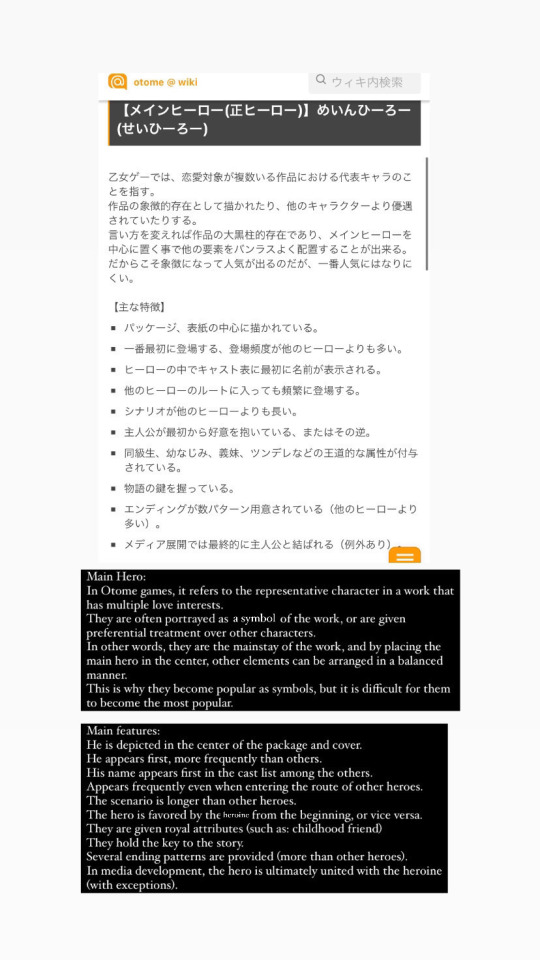

As for Ayato, he is seen as the main hero by Rejet and Japanese audience, that’s what matters the most. When he was asked if his opinion about Ayato changed before and after the anime, even his VA said “no”, because, according to him, Ayato is a character that can easily be the core of the story (主軸). In the least biased way, that's a true statement, given that he got that main character charisma and energy, plus background.
From my perspective, he got an amazing world building, and whoever thought of that is a very clever person (or people, if there were more)! I like how everything makes sense, it's a bit weird how they only released YB manga recently but at least it solved a "mystery".
We can see in the last YB chapter how he became addicted after eating that fig. "Addicted" is literally the name of his character song, and its lyrics perfectly describe the entire fig situation (translation by silvermoon249).

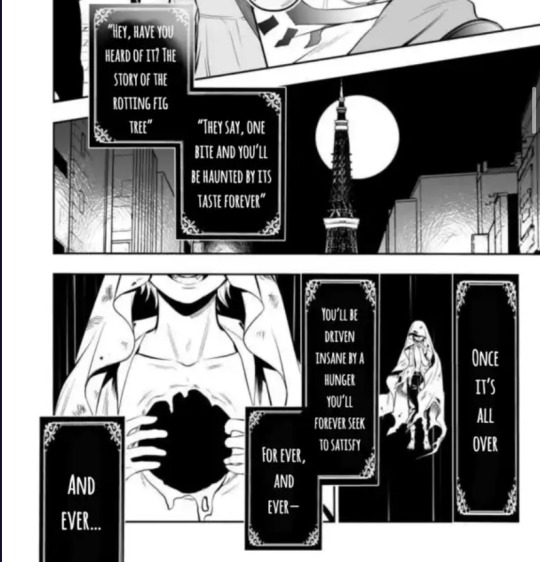
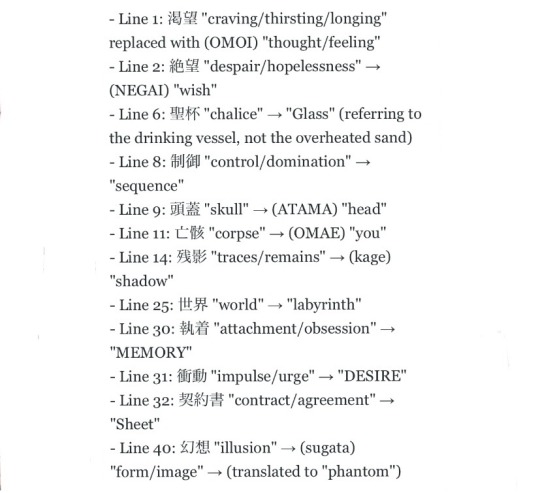

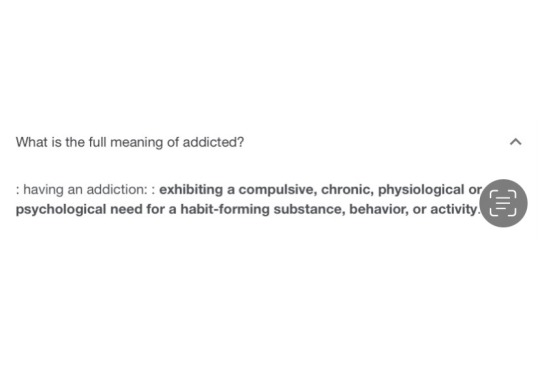
Last but not least, I have such a love-hate relationship with this official short story (translation by Koiiro) because 1. that’s the best confession Yui has ever made and 2. it sounds kinda creepy?? The atmosphere was quite disturbing; Yui didn't even seem embarrassed, which is unusual for her, and even Ayato found the situation strange. It has a strong "everything is always connected" vibe to it…?
Welp guys, don't be sad if you haven't found your soulmate yet. Ayato had to wait hundreds of years for it. xD
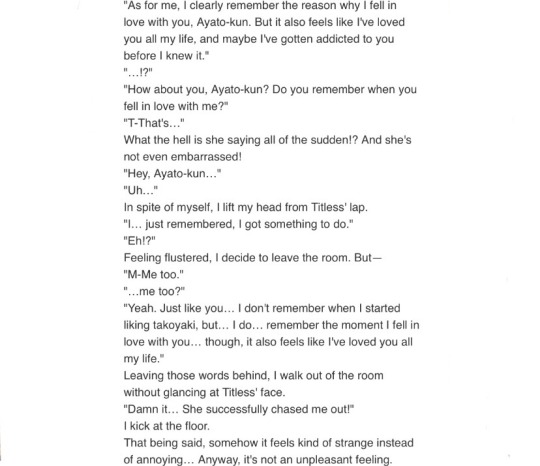
I truthfully agree with the part about localization. It's not like DL doesn't get one due to the themes presented there, because there are localized otome games with far darker themes, but I feel like the English fandom really doesn't deserve one (I'm not referring to everyone, there are some genuinely kind and calm people). They complain about everything Rejet releases, they are petty and too salty, they abet, and they have no idea how the otome game world works... To summarize, they aren’t able to appreciate anything. As a result, DL should be limited to the Japanese audience, who are far more understanding and supportive.
118 notes
·
View notes
Note
am I the only one who doesn't feel represented when it comes creating female lead in general?? i see rare unique and different female mc or characters compared to the typical female lead of interactive choice-based games.
my mc or me personality is more challenging and rebellious, she has that macho attitude and knows how to push someone's buttons. She is muscular and aggressive with a "what's up bro" and "nah fuck that fuck society" vibe, unlike the soft, pale as snow with "cute elegant clothing, long lustrous hair, slender physique and a quiet pleasant personality" typical female lead. there is nothing wrong with cute gals, they cool, they cool, but they're other gals then the submissive ones.
i do enjoy the game, let's be honest, who can survive simeons charm?? but i don't actually feel myself when i play as mc if you get what i mean. this wasn't only for tomboys tho it was for female mc in general who don't find themselves in mc, not getting represented. i gave my example and my struggling.
I think this is an issue for a lot of otome style games. I find that I don't like playing ones that have an actual image for MC. If they don't use the pronouns too much, I can usually gloss over that stuff, but the MCs are so very different from how I identify as a person that I can't self insert at all. (Not that I would if I could, to be fair.)
In fact, I feel like Obey Me is the only game in this genre that hasn't been as bad. (Well, Arcana was pretty good with this too since they let you choose your pronouns but I haven't played it in a while lol.)
MC is gender neutral by default, so they have that at least, which is more than I can say for most otome games. However, the personality problem still exists in OM and really I'd say it's just as bad as most of the others. Generic OM MC has some funny and unhinged lines, but most of the time everybody talks about how nice and sweet they are. I mean, we all joke about them being the demon therapist, but that's really how it is.
On the one hand, it's kind of annoying because you're right. Different types of MCs just don't exist really. And since the default is often female, it's like the one personality they think anyone female can have.
On the other hand, they're going to have to do this at a certain level. They can't give MC too much of a personality. In the end, they're still going for a target audience and I guess they think most female players are going to want to be portrayed as nice and sweet MCs?
All that rambling aside, your feelings are completely valid. To be honest with you, I don't see this changing in otome style games any time soon. So the best we can do is imagine the story differently for ourselves!
So many times I've been given a set of dialogue options for MC and been like... okay neither Ciaran or I would say any of those things. Here is what Ciaran would say if they were experiencing this moment! Then I choose the dialogue that's closest. Or if it's main story, I choose the ones that I think will raise intimacy lol.
Anyway, I don't think you're the only one. I think this is a pretty common feeling. And maybe one day someone will make an otome or dating sim game where the MC has a more rebellious attitude or is female but muscular. It says a lot about how women are perceived when the "generic" female lead is considered to be a nice and meek type of person. It's an unfortunate circumstance of society.
#tbh I would also be thrilled to have a muscular female love interest#obey me#anon asks#misc answers
19 notes
·
View notes
Text
I was scrolling through TikTok, and I came across a very interest one. The TLDR is that with the runaway success of the FNAF movie Hollywood studios like Disney are gonna try to create more movies targeting a fandom over general audiences. To be honest, I completely agree. Knowing how Hollywood works, I think this is highly likely, because they want to cash in on the same success.
(While some people may argue that the Sonic, Super Mario Brothers or Barbie movies marked this turning point, these properties have been around for decades enough to make them appealing to both new and old audiences. Whereas something like the FNAF movie it's only a decade old and really only people in Gen Z or the critically online really knows about it. Hell, I've seen actual TikToks of people having no idea what the FNAF story is about!)
In light of this, one prediction I have is that Disney is gonna try to push Twisted Wonderland and Kingdom Hearts in order to make them their own "FNAF". They are both based on Japanese video games with deep lore, wonky writing and a built in fanbase. It's possible for Disney to lean in on this and create tv series or movies, especially for Kingdom Hearts.
I also think that if Yana made it a mixed gendered school from the get-go, she would've created Disney's FNAF. The only thing turning people away is people believing it's an otome game with all of the anime hot boys. But if that wasn't a factor, I can see it being as popular as FNAF. People are disillusioned with Disney rn for things like not adding in romances, the lack of 2D animation, childish stories and no villains. TWST cashes in on a lot of those. I imagine that the anime would be 2D, the Japanese version can get REALLY dark at times and it centres around Disney villains.
But at the same time, I'm glad that's not the case. I think if that was true, then the game would attract a lot more bigots and right-winged dipshits who treat Disney like they are the devil. (Okay, Disney is the worst. But not for including diversity like they claim! Hell, actually falter a lot when it comes to that!)
Blessing and a curse for the game. But either way, I wouldn't be surprised if Disney pushes either of these in the future.
2 notes
·
View notes
Text
Some fun talking about and analyzing the tri. stage play, and its relationship to Kizuna
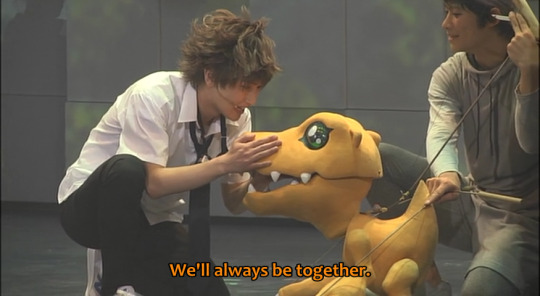
The tri. stage play (full title: "Super Evolution Stage! Digimon Adventure tri. August 1st Adventure") is honestly quite an unusual entry in this franchise, even within Adventure standards. Nearly everything about its production is unusual -- the entire genre it's in is unexpected, the choice of time period to release something like this is unusual, and moreover, now that Kizuna’s out, a lot of people have noticed a lot of suspiciously similar themes and even language, most notably the key “we’ll always be together” line (phrased even exactly the same way in Japanese). In fact, despite ostensibly being a tri.-branded product, other than a few vague token nods to the anime series in the play itself, said stage play has very little to do with the actual anime sharing its name, so the similarity to Kizuna is even more striking in retrospect.
Perhaps another interesting thing about this play is that it’s a very good example of a standout work in the Adventure universe that didn’t have any original creator involvement (other than some minor tips from Seki). I think there’s often a tendency for people to think that in order for a sequel or spinoff to be true to the original, it has to have some member of original staff on there, especially since the Adventure (and 02) characters tend to be a bit overly complex and it helps to have the reassurance that someone who knows them is behind the wheel -- Kizuna used the presence of Seki and Yamatoya as an outright advertising point -- but this stage play’s director and writer had no experience with the franchise beforehand, not even as a fan, yet still made a very respectful product that has generally been received well by Adventure (and 02) fans and even got the original director’s approval, too. If anything, that makes it all the more impressive!
(Note that the below text spoils the story content of the play, but not Kizuna’s to any substantial degree.)
Some production background
Anime and video game stage tie-ins are fairly common -- much like this one, they tend to have very short runs and are targeted at a limited audience -- but they’re usually stereotyped as being for the otome crowd (i.e. predominantly female otaku audience), so works like this are generally associated with it. As a result, when this play was announced and released between tri. Parts 4 and 5, quite a few people were surprised, because this franchise originally came from products associated with shounen anime. In practice, this was a period where it was becoming increasingly clear that there was, in fact, a huge female audience for Digimon (especially Adventure universe), on top of the fact that (as noted by the performers in the final show) the audience for this show ended up being unusually mixed-gender, because Digimon really is universal -- but it did lead to the announcement of the play being initially received with heavy skepticism, partially because of the usual misogyny (stigma around things associated with female audiences, etc.), and partially because this was during a time where...well, saying that a very huge percentage of the fanbase, especially the Japanese side, was really pissed off at anything tri.-branded at the time is kind of an understatement. Ultimately, the play ended up very well-received with a small but dedicated following, and it’s currently referred to as “dejisute” (short for “Digimon Stage”) in Japanese fan shorthand. Bringing it up generally elicits positive critical feedback, even among those who were initially skeptical.
Some interesting things also surround the circumstances of its production as well. As some might know already, the tri. anime series and Kizuna share only one key member of staff: Kinoshita Yousuke, who was involved in tri. Parts 5 and 6, and eventually went on to become the producer for Kizuna and the upcoming 02-based movie. tri. was a work that (for some reason) had a huge number of producers on it, of which Kinoshita was only one; he seemed to have been replacing Arai Shuuhei, who left the project after Part 4. However, while Arai was formerly one of the most visible of tri.’s producers (he was the only one regularly brought up in interviews), how much degree of influence Kinoshita had with tri. is unknown, other than the fact he had no involvement in its story. Given that the decision to make Kizuna also seemed to have been made around Part 5, it seems that Kinoshita may have been brought on specifically for the purpose of observing and prepping for Kizuna, because his role on tri. seems to have been so minimal that the moment he was put in charge of Kizuna, the production philosophy ended up becoming completely different under his management. (When you think about it, tri. and Kizuna have very little in common, other than the rough premises of involving the older Adventure cast.)
The thing is, though, Part 5 isn’t actually the first tri. work Kinoshita is credited for, but this stage play is -- which is interesting to consider when taking into account the heavy amount of thematic parallels between this and Kizuna three years later, and in general the very unusual creative decision to make a stage play that suddenly popped up at exactly this time, making heavier tributes to Adventure (and even 02) than the actual anime it was branded with. Making things even more interesting was that the stage play’s director and writer, Tani Kenichi, was allegedly recruited by an unnamed producer impressed with his work (by the way, did I mention Kinoshita used to work in live-action before joining Toei?). Given all that, perhaps this stage play coming off unnervingly like a sort of Kizuna prototype isn’t all that surprising...
Unfortunately, right now we’re still kind of in a time period where official will get barraged with violently angry comments for even so much as putting the series on streaming services, so it’ll probably be a few more years (if ever) before official will be willing to be more open about what went on behind tri. production, and it’s probably a bit much to get too speculative about things like this when real people are involved. Nevertheless, one thing is apparent: the director and writer, Tani, was a newcomer to Digimon -- not even someone who’d been a fan beforehand -- but watched all of Adventure and 02 in preparation for it and stated openly that he was very, very emotionally touched by it. The work itself is obviously made with a lot of love and respect for the series, and one really cool thing about it is that you can also tell that it came from the perspective of an adult with no preconceived notions about it, therefore meaning it comes from someone analyzing the series without necessarily caving to fanbase mantras, and making some very cogent observations about the characters. It’s also just a fabulous work production-wise in general -- the puppet work and making the Digimon look convincing on stage is very well-done, especially when you consider that this play had only ten showings -- and you really gotta appreciate the fact that, even before Seki gave him a few pointers, he was so passionate about the importance of Digimon partners that he pushed for all eight to be represented despite the expenses.
Taking a look at the play itself
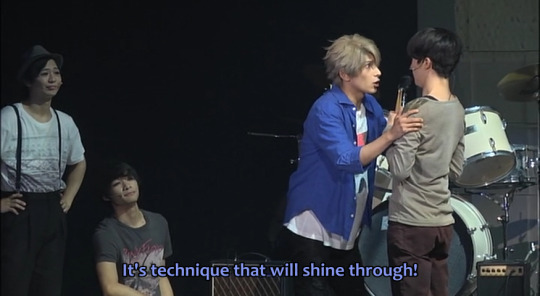
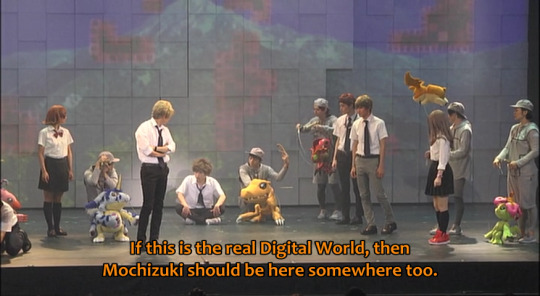
Despite ostensibly tying into the tri. anime series it's branded with, the play only really seems to loosely refer to some of its key elements as taking place at approximately the same time, such as Koushirou’s server, infected Digimon, setpieces like KNIFE OF DAY, and an eventual “reveal” that this seems to take place ostensibly around the rough time period of tri.’s Part 4. Look closely, however, and you’ll notice that a lot of things in the characterization and plot arena actually don’t track much with tri. at all -- for instance, in a very non-comprehensive list of things:
It’s implied that Yamato himself is embarrassed about the KNIFE OF DAY band name and is desperately trying to get through it with passion, which doesn’t quite line up with his attitude about it in the anime.
The timeline just really doesn’t line up; Mochizuki Meiko, Meicoomon, and the infections obviously exist, but you can’t have a time period in Part 4 where the kids recognize Meicoomon as being related to the distortions or infections while also being separated from Meiko. Moreover, the “reboot” just doesn’t seem to have happened at all (and to be fair, if you’re planning on making a two-hour tribute to Adventure, not having the Digimon with memories of said adventure would seriously limit the scope of your plot, so this kind of “leeway” was probably downright necessary).
The tri. anime series portrayed Takeru as having a very sharp shift in language, presumably under the implication he’s putting up a front as a flirtatious, aggressive playboy, and so his first-person pronoun was turned into the aggressive ore and his way of referring to Yamato aniki. In Adventure and 02, Takeru had used the polite boku and childish/cutesy onii-chan, and the boku was prominently used as a plot point to hint at Takeru’s identity as the series narrator. (Yes, these kinds of things are actually kind of a big deal in fiction.) Since even longtime fans generally agree that at some point Takeru would be likely to stop using onii-chan once he became old enough, the stage play likewise also prefers aniki over onii-chan, but, notably, it doesn’t even bother with ore in the slightest nor any of the implications that surround it, and Takeru comfortably uses boku for the entirety of the play. Considering that the use of aniki is still a bit unusual (both Diablomon Strikes Back and Kizuna prominently favor the slightly more polite nii-san instead), it seems that the play was made with an awareness that both aspects of Takeru’s language had changed, but a conscious decision to hold over only one from the anime.
And so on and so forth.
In general, the way you could describe this play’s handling of Adventure universe lore and characterization elements is that it’s a bit selective about which tri.-related elements it makes use of, particularly in regards to ones that might be too difficult to reconcile with the original Adventure (and 02). (This is basically the same attitude Kizuna roughly takes in regards to handling of tri. elements, although it’s less noticeable there partially because of the five-year gap between tri. and Kizuna.) Obviously, being completely incongruous with the tri. anime would be a pretty crude thing to do for a play that’s actually branded with it (and especially when said anime was still ongoing at the time, regardless of public opinion), but, regardless, the end result is that its actual relationship with the tri. anime’s version of canon is a bit tenuous.
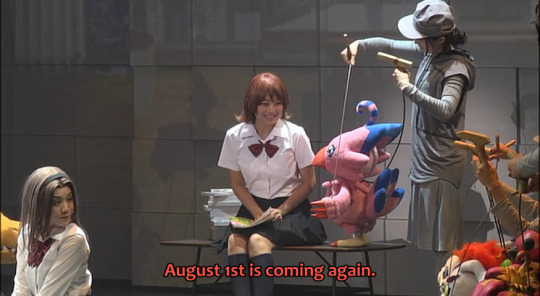
The main reason for this is probably that, on the flip side, the stage play's references to Adventure -- as in, the specific series that aired in 1999-2000 and took place in the in-universe August 1 and 3, 1999 -- are incredibly aggressive. In fact, it’s actually far more aggressive in this respect than Kizuna is. For all Kizuna is branded as an Adventure movie and puts the original Adventure cast first and foremost in all of the advertising, if you watch the actual movie, in practice, it’s more of something that lies in the gap between Adventure and 02 and the two series together as a whole. Adventure was a series that practically revolved around a "trapped in another world" story and the specific impact its events had on the kids involved, but Kizuna focuses more on the “larger world”, including real world society (very much 02 things), with a lot of themes with suspicious pertinence to 02 and references to its epilogue looming over the plot; the specific Adventure references and even the Digital World don’t come into play until the climax. (And that’s before we get into the fact that the 02 quartet gets more screentime than a good chunk of their seniors.) Really, you can see it just by the fact that a majority of the primary key visuals line the 02 quartet up with everyone else; it’s a movie about both, not just Adventure.
So in other words, Kizuna is really about mixing Adventure and 02 elements, serving as a sort of stopgap work, and recasting the Adventure group in a lot of 02′s context. (And that’s by no means a bad thing; since Adventure wasn’t about that, the differing juxtaposition is a fresh perspective in its own way.) But in terms of revisiting what the actual series called Digimon Adventure was and how those events might have an influence on its relevant cast years later, this play (which actually has longer runtime than Kizuna, being around two hours) is a good place to go to if that’s what you’re looking for. The entire premise of the play revolves around copiously referencing that specific adventure back in 1999, and, more importantly, what impact it’s still continuing to have in this particular group’s memories, to the point where they’re starting to romanticize it and wish they could return to it forever...
Ah, right, that’s what this play has in common with Kizuna: the overall theme of unhealthy fixation on rose-colored nostalgia, and the need to move forward from it. (And, driving it home, “unhealthy fixation on the events of Adventure” as a symbol of that rose-colored nostalgia, to boot.)

The premise of the play itself is that the kids decide to hold a camping trip as tribute to the adventure in 1999, as part of a desire to "go back to those times" (and, as is eventually revealed, it’s actually part of a pocket universe their subconscious wishes had dreamed up as a desire to recreate the past, thanks to the power of the Digital World). So all of the references to Adventure are concrete and fleshed out in specific detail, ranging from everyone referencing specific events and how they impacted them (Jou very explicitly refers to his experiences in Adventure episodes 46-47 in terms of why it fuels his current desire to become a doctor) to even the most minor of references (direct reference to bananas on File Island, from Adventure episode 3).
As a brief aside, a positive side effect of centering the plot on this specific adventure is that it justifies the reason for why these eight are working together (at least prior to the endgame reveal that they’re still involved in tri.’s events); the eight of them weren’t portrayed as liable to do so without good reason, and while certain aspects and events from 02 are alluded to when they’re relevant, the absence of the actual quartet passing without note is completely justifiable because they simply were not on that adventure anyway. (They weren’t initially planned to be at the event in 02 episode 17, and knowing them, it’s likely they wouldn’t want to be at this kind of outright commemorative camping event, because they’d feel like they’d be intrusive in something they had nothing to do with.) So within the scope of the play in two hours, the narrative can be very neatly condensed to be mostly about Adventure itself.
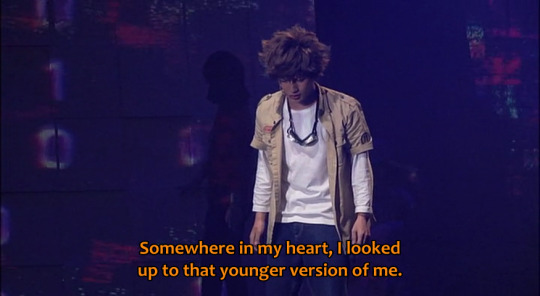

Although this play and Kizuna both share the common theme of the existential crisis that comes with getting older and the tendency to romanticize one’s childhood, the underlying reasons are a bit different; Kizuna’s is very close to 02 in that it’s largely to do with societal pressures and expectations, especially since the question of "what you want to do with your career" is a driving motivation in it. In other words, the existential crisis comes from living up to other people’s expectations, or trying to fit into an arbitrary societal mold of an “adult” without necessarily knowing if that’s what you really want. In the case of this stage play, being set in everyone’s high school years where everyone’s relationship to “the world at large” is a bit more tenuous, the reason for the existential crisis is somewhat closer to Adventure’s: everyone’s started to think they might have been better people back then. More confident, less hesitant, more honest with their feelings. Adventure was a series about self-improvement and one’s relationship with oneself, so it’s understandable that a work meant to look back on that specific adventure will ask the question “well, did they become better people after all?” as a result.
But there’s two problems with this line of thinking: one, this is a very rose-colored evaluation of their former selves, because just because they might have been “more confident” back then doesn’t mean they didn’t have other problems going on (Hikari calls her past self out for being arguably “more honest”, but also somewhat of a dependent child), and two, being more hesitant doesn’t make one a weaker person, just one who’s dealing with a lot more problems and awareness and things to worry about because of how much the scope of their lives has increased. As Agumon says at the end, the old Taichi and the current Taichi are still the same person; it’s just that he’s dealing with more, so he’ll naturally worry about more, and taking on those extra burdens is actually his own way of “evolving”.
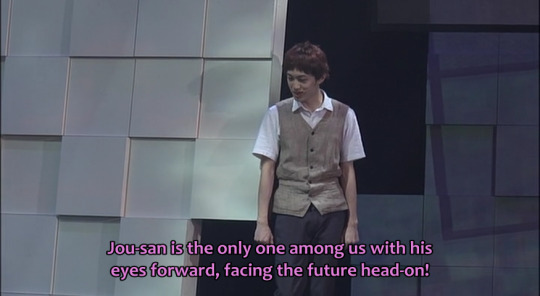
Particularly interesting is the position of Jou, the not-so-unsung hero of this story, who is explicitly identified as the person most clearly aware of his future dreams and proceeding without hesitation towards them, to the point of being somewhat immune to the effects of the dream world. (Somewhat, mainly because the ending establishes that he wasn’t entirely.) It's consistent in line with the fact that we actually saw, directly, the train of thought that led to his decision to become a doctor back in Adventure, and he even states it directly in this play himself: he doesn’t consider himself someone who wants to solve things through fighting, but rather someone who can prevent casualties and heal the injured if he pursues this line of study, and thus is determined to make it happen. Even from the very early points of the play, there are several hints at him being able to see a metaphorical “future” that the others cannot, and while he remains unfailingly loyal to his friends (there’s a long sequence of him constantly claiming he’ll leave them as per Koushirou’s request but constantly coming back because he just can’t bring himself to abandon them), he also is the first one to depart the camping trip to attend to a test -- that is to say, he treasures his past, but he has a strong enough dream for his future that he’s willing to move on better than the others can.
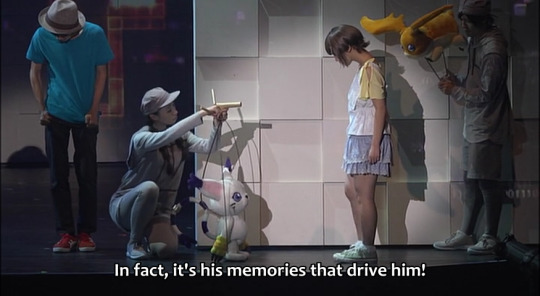
Jou’s also the one to personally advise Yamato about the difference in nuance between doing things because you feel you must, versus doing it because you yourself truly want to, a difference in nuance that also becomes very pertinent in Kizuna. Also pertinent to both works in common is the discussion of nuances between “staying trapped in one’s memories” and “violently cutting them all away” (the consequences of the latter being more extensively discussed in Kizuna), versus the ideal situation of reflecting on those memories and experiences from the past in order to productively move forward.

And in the end, rose-colored nostalgia is, indeed, rose-colored nostalgia. Because, sure, that adventure back in the day was great, and they grew a lot, but they also grew a lot because they were overcoming some very harsh, difficult troubles; omitting those parts is losing the substance. The re-invocation of the fun “camping trip” also means re-invoking all of the other things that came along with it, including all of the dangerous threats they’d faced back then. It’s a package deal, and you can’t just filter those out, because it misses the point of what you gained out of it in the first place.
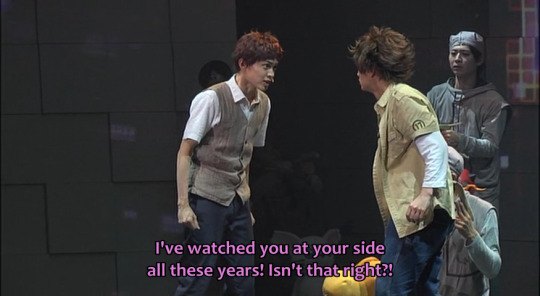
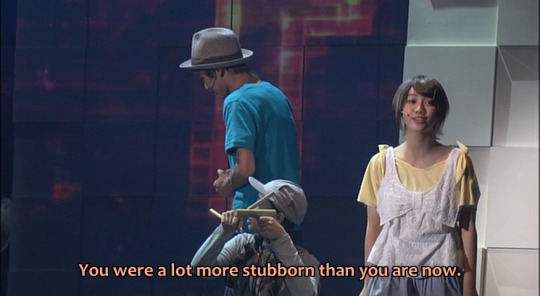
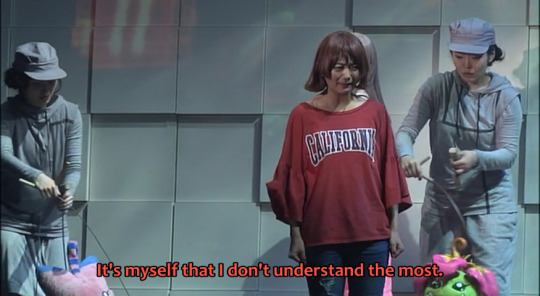
In general, the character writing for this play is also very good; there are some differences between the characters here and them back in 02, but they’re all within the believable scope of positive progression within three years and general adherence to core tenets of their character (Koushirou is certainly more assertive, but emphasis continues to be placed on his deference to others, penchant for spotting details, and capability for being an organizational leader in his own sense). Also notably, this play manages to verbalize a lot of the subtleties in Adventure and 02 that the mainstream tends to gloss over (and don’t tend to get put in official profiles) but are well-known to those deeply familiar with the series. This is the kind of attention to detail usually associated with those who have been studying the series for years, so it’s refreshing to see these come out in words -- for instance, Koushirou stating outright that he was one of the closest people to Taichi for a long time (very true!), Hikari and Takeru actually commenting on each other from back in Adventure (something we never really got in 02, despite “them having known each other for a while” being part of their character arcs), and Sora explicitly admitting that she goes out of her way for others because it’s easier to work for others than it is to even think about herself.
Actually, the attention to detail in general is fantastic; other than a minor slip-up (Sora refers to having met Koushirou during the summer camp at the beginning of the play when she’d actually known him prior from the soccer club, a detail that’s very easy to miss because it’s only mentioned once in Adventure episode 16 and clarified further in the novels), a lot of things from Adventure and 02 are made use of and framed in very clever context; the choice of Etemon as the enemy for this play is well-placed for both his entertainment value and the fact that, as an enemy personally defeated by MetalGreymon in Adventure episode 20, it makes perfect sense that he would have a grudge against Taichi in particular. (It’s also explicitly mentioned that Hikari and Tailmon never met Etemon in person even once, and that Taichi never actually got to see MetalEtemon, so there’s a lot of attention paid to logistics like that.)
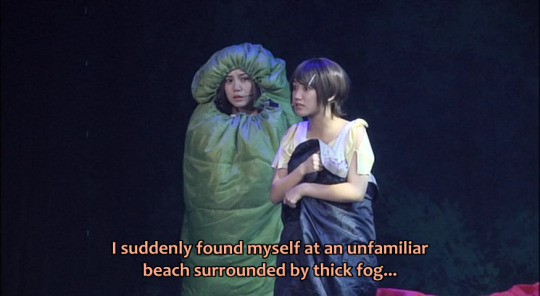
Also, while 02 is not really brought up within the scope of the story (and really shouldn’t be, not when this story so heavily centers around Adventure and its themes), its place in canon and its contributions to the worldbuilding are fully respected; a lot of the offhand references to family situations and background are elements that were originally introduced in 02, and many aspects of its Digital World lore are used to assist the plot premise (in particular, the idea of the Digital World being connected to something that can conjure up unconscious dreams wasn’t explicitly invoked until 02). Rather amusingly, at one point, Hikari uses the events of 02 episode 13 to tell a “scary story” to troll Mimi, and it’s interesting and rather refreshing to see the implication that Hikari’s been able to move past the incident enough to use it to troll someone else. There are also some latent epilogue references as well, with Hikari directly bringing up her goal of becoming a kindergarten teacher, Takeru making some really subtle references to wanting to be a novelist and chronicle their adventures (in true Takeru fashion, he never states it outright, but anyone familiar with the epilogue can figure it out), and Taichi alluding to an ultimate goal of humans coexisting alongside Digimon.
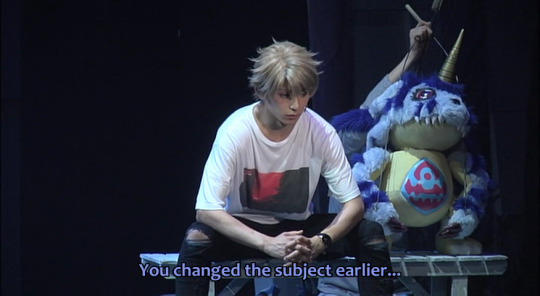
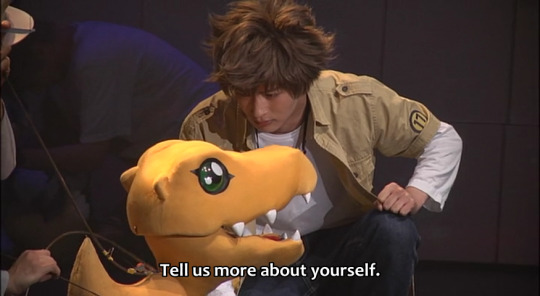
Finally, attention should be called to the play’s relationship writing in general. As stated before, the play does call attention to relationships between characters that often don’t get brought up by the mainstream but are somewhat more well-known to fans -- Koushirou and Taichi, Sora and Mimi, Jou and Yamato -- but even the well-known ones are treated with nuance endemic to that from Adventure and especially 02, given that Taichi and Yamato don’t actually have the stereotypical “cold rivals” atmosphere that shounen anime would usually suggest, and the two of them have an extended heart-to-heart in which Yamato actively tries to figure out what’s wrong with Taichi and treat him kindly. (Like in Adventure, the only time they break out in a fight is when Yamato gets emotionally compromised and starts worrying that Taichi isn’t doing enough for others’ welfare.) It’s also very consistent with how the two treat each other in Kizuna as well (the izakaya scene comes to mind, and has a lot of similarities to the awkward-but-ultimately-close conversation they have at night in this play).
And, of course, the centerpiece of the narrative overall: the human-partner relationship. Of course, a lot of this was probably helped by Seki lecturing Tani to not mess this part up, but it really is impressive to consider in light of the fact we’re working with a lot of puppets that have handlers clearly in plain view, so you have to have some massive suspension of disbelief to make this work. But not only are the movements well-done to make it convincing that you really are seeing these actors physically interacting with their partners on stage, the narrative also puts huge spotlights on them, making the Digimon outright be the ones to snap their partners out of their worst patterns of thinking (especially with Agumon and Taichi), and dedicating a long period of silence where literal stage spotlights are dedicated to each kid having some alone time with their partner. The intimacy is very convincing, and, truly, Tani’s insistence on making sure every single one of the main Digimon was represented in spite of the prohibitive budget paid off very well. The point is made: a Digimon partner has to be someone who knows you well and intimately and can call you out at your worst moments, and Taichi even spells it out: Agumon’s capable of seeing right through him.
Putting it next to Kizuna -- a movie dedicated entirely to examining the meaning of a partner relationship, what happens when it deteriorates, what that means for oneself, and what it takes to recover it again -- it’s perhaps unsurprising that this play ends on the same line that was used in all of Kizuna’s advertising and was central to its own plot: “We’ll always be together.”
65 notes
·
View notes
Text
Information as to Why Twisted Wonderland is NOT an Otome or Dating Sims Game
Hello Everyone! It’s been a while~ ヾ(•ω•`)o I finally found the courage to write Twisted Wonderland content after what happened a couple months ago, when I literally just came back, and while writing a couple of analysis I thought I would write this as an informative rather than an actual analysis of the game.
DISCLAIMER: This post is NOT by any means demeaning otome games or dating sims whatsoever. This was written to clear the misunderstanding people had on the genre of Twisted Wonderland and that anyone should be allowed to be play without feeling restricted or thinking it’s not something they want to try because of misunderstandings. Do NOT use this post as a source to offend people but please use it to inform others.
It’s no longer old news that Twisted Wonderland frequently gets called an “otome game” or dating sims by people who never played the game before. People on twitter, youtube, and even those that were trying to or supposed to advertise the game have often categorized it as such. This wouldn’t have been such a big deal had people recognize and acknowledge that the game isn’t after being explained to about it, but after hearing their arguments as to why they refuse to change how they think about it, the frustration pent up for nearly a year has finally bubbled over. Buckle your seats everyone cause today is the day this argument ends once and for all!
First off, let’s start off with what makes an otome/dating-sims an otome/dating sim. Both are very similar, where, according to Japan’s Wikipedia, Nico dictionary, Kotobanks, and many more Japanese dictionary sites, otome games (i.e. 乙女ゲーム) are games which includes a female MC who has the opportunity to attract the very attractive male characters in the game and enter a love route with each of them separately or harem-like. Dating sims are a bit different. Dating sims (i.e. 恋愛シミュレーションゲーム) falls into to two definitions with the first one being the exact reversal of otome: MC being male, the love interest characters being very attractive females. The second definition is the one many are familiar with – a romantic visual novel. Believe it or not the first definition is the original definition of what dating-sim games are, the second meaning derived from many attempts of using the term “dating-sim” incorrectly by the English speaking gamers to the point society now believes it’s the actual meaning.
However, this difference doesn’t change that both otome and dating sims are very close. Both genres include gender-specific MC(s) (there’s been games where a player can play either male or female), handsome/beautiful characters with their respective love routes, and a main plot to follow. In addition to this, when the game is in mobage format, there’s going to be showers of fan service in the form of events and gacha-cards, though, arguably, it doesn’t change the fact that the MCs would still be interacting with the characters romantically.
So, from the explanation written above, Twisted Wonderland falls into that category, right? Sorry not sorry, that’s wrong. Sure, Twisted Wonderland has many characters to swoon over since…I mean…they’re drawn and written by Yana Toboso and her staff and…there hasn’t been anyone so far who had the capability of saying no to characters she personally had drawn or created. But! It doesn’t mean that the game is a dating sim or otome.
One of the reasons Twisted Wonderland isn’t one of them is how the game is set up. There are no routes the MC can enter nor can the MC pick and choose which characters to focus on in general. Like FGO and Granblue Fantasy, the MC solely follows the main plot and has to interact with all the characters they’re introduced to whether they like it or not. The same logic is applied when playing events – the MC will be participating and talking to all the characters involved in the event. Not once does the game give the opportunity for the MC to choose who they can talk to and participate in the event with the person they chose. The only time it’ll be one-on-one is, most of the time, getting the desired character’s card through gacha or when the event sets the story where the MC has no choice but to talk to a character one-to-one. For the latter though, the MC isn’t going to be able to wish for the character they want to talk to – it’s completely random and up to the writers who they want the MC to interact with.
For otome and dating-sims alike, especially in mobage format, the MC has the opportunity to choose who they wish to focus on and interact solely with the characters they chose whether it’s the main story, event, and card story. It can even be arguably said that otome and dating sims focus solely on the MC and their love interest interaction more than anything else. As for Twisted Wonderland, again, that does not happen. Twisted Wonderland, in addition to progressing the main story and revealing more about the characters involved, focuses on everyone’s interaction with each other including the NPCs. The game shows the other characters that aren’t interacting with the MC talking to other characters and what role they were playing while the MC was busy with the group the writer had them interact with during that time. Even in the card stories, most of the card stories involve more character-to-character interaction rather than MC-to-character interaction.
Speaking of which, the MC in Twisted Wonderland, the game, is gender ambiguous. Not once did the game developers and story writers mentions the MC as a specific gender like the other romance games. Heck, most of the characters don’t even use a gender-specific pronoun such as 彼女 (“kanojo” = she) or 彼 (“kare” = he) when referring to the MC. They usually refer to the MC by their given position, 監督生 ( “kantokusei” = prefect). The only exception is when the game’s mascot and MC’s buddy, Grim (the blue-fire monster), who uses あいつ ( “aitsu”) which is a gender neutral pronoun that holds the vague meaning of “that one” or “that person”. There’s also the fact that the MC’s default name is ユウ (“Yuu”), which is name used by either genders in Japan and how the MC uses gender neutral pronouns when regarding themselves as 自分 (“jibun”) and others as 貴方/あなた (“anata”).
Even during the official advertisement, official summary, official game archive book ( i.e., Twisted Wonderland Magical Archives), and posts made by the staff on twitter, not once did they specify the gender of the MC. In fact, they never once even specified the gender of the audience they’re targeting the game towards nor say anything about there being romance or any hints of harem-esque situations that involves the MC in any shape or form. The most “direct” statement made by Twisted Wonderland’s staff was from an email a fellow Twisted Wonderland fan had sent to the staff after a magazine had advertised the game as “Disney’s first game for women”. The email from the staff mentions that they wanted the game to be enjoyed by everyone, REGARDLESS OF GENDER. (link to said post here)
If they had any intentions of making the game otome-like or dating sim-like, Aniplex, Disney, and Twisted Wonderland staff would’ve mentioned that the game has romance or the possibility for there being romance when releasing the story summary, game system set up, and their ads. Not only would they have done that to get the audience they wish to target but speaking of it legally, they are required to mention it since there’s liability on their part on informing their customers on anything they need to know in regard to the game they’re playing. Age restrictions, fees, game play, and the like – Twisted Wonderland also had to go through the same process like any other visual novel games to be developed and released.
In a way, Twisted Wonderland can be seen as another Touken Ranbu or KanColle, but with an actual main story plot to progress through. All three games’ MCs are gender ambiguous, great characters to throw-er-spend money on, and have fun game plays. Sure, unlike Touken Ranbu and KanColle, where their MCs continues to be gender ambiguous in their anime and manga adaptation, Twisted Wonderland’s MC in the manga adaptation ended up being male – however, a statement was released by Yana revealed that the MC in the game and the MC for the manga are not the same people. (Link here) Meaning, the “real” or “official” MC’s gender continues to be gender ambiguous for the sake of continuing to attract all genders to play the game.
All of this being said, Twisted Wonderland is a fun, visual novel game and supposed to be enjoyed by everyone – each to their own way and passion. No one shouldn’t be discouraged from playing it solely because of false advertisements or misconceptions made by others who haven't played the game yet.
I hope this clears things up and hopefully helps others persuade people into playing the game!
119 notes
·
View notes
Note
Lore Here: To me the only thing that could make a Female Yuu fit in is if Twst has a Spinoff where the schools are Co-Ed than an 1 Gender school. It would make her fit in since there female students she can interact with while still being friends with Ace and Deuce. And like I said, I prefer having female characters treated like normal people than an object of simping.
Not necessarily; as I just posted in an added note to a previous ask, Yuu is a special case in the world of Twisted Wonderland: They don't know where they are, they have nowhere to go, and since they manifested out of a coffin inside Night Raven College, and it's not like this is something that could happen to anyone by mistake, it is Crowley's responsibility as the Dean to figure out what happened, how it happened, and what they can do about it; figure out how to send Yuu back to their own world.
Like, a female Yuu might feel uncomfortable or lonely having no other girls to talk around but, again, this is one of those situations where It Is What It Is.
The game already breaks some patterns and norms and gives the guys personalities besides horny teen male character, so it's not like Yuu would suddenly be the focus of romantic attention; the cast seems to be more focused on things other than romance like their careers and such, and, I mean, look at how they failed with my girl Eliza lmao.
~Mod Lag
I think you are mistaking something here. The all male cast isn't male empowerment, but female empowerment in the meta level. Out universe. Back in the day, devs doesn't think women worth the market, that they shut down the women fandom instead (it happened back in Rurouni Kenshin days, that dev shut down the women fandom who simps for the mc, because back then devs thin women are just men's tool, with no money to spend on their own, to sit nice , be a doll or do housechores) . That they are admitting women are now people who have money of their own to spend , that they are profitable, worthy market to milk off their money, instead of just dolls to be pure,to admit women are people on their own who can be horny too, is also women empowerment in meta level.
The fact that this game make like 240KUSD in TWO YEARS , beating the likes of Final Fantasy Brave Exvius is proof that straight women is also big, profitable market , though men can be more profiting because how impulsive they are (you know the story of a man spending his vacation savings for his waifu in FFBE?Or some men make loans to spend for their waifus in other games? Yeaaaah, that)
The game is made by a woman who fetishize men , so the women audience can simp and objectify the boys. It was made by a woman, for women to simp men, again, it's women empowerment in the meta level.
It's what joshimuke stands for. It's game aimed for women, regardless it has dating element or not, when otome is strictly dating games for women. An otome definitely is a joshimuke but a joshimuke isn't always otome, as long the target market is women, it's a joshimuke. Like say, Free. that anime is joshimuke but not otome.
I can still complain that devs tends to make joshimuke have trashy gameplays is sexist, to say women have no interest in gameplay, but alas, looking at how people react to the difficulty of the minigames in part 6-2-2 I can't say the sexism lack base....
How do you tell the difference of a male power fantasy and female power fantasy? Simple, look no more to isekai genres.
Isekai genre for men tends to transport the mc to pseudo-medieval era, heavy on action, as well the definition of the "op" is always combat-related , be it directly or indirectly like summoning some creatures, and often, it has the "violence is the solution" formula often present in shonen mangas, as well usually based on JRPG roles and tropes. So basically like Epel. Epel is portrayal of those "violence is cool/solution to all problem" kind of guys , again, that's just so realistic personality of men.
Isekai genre for women tends to transport the mc to pseudo-victorian, with either the mc or the love interest are nobles, with the definition of OP isn't just in combat, but also, in politic ad wealth. The MC is often cunning and do their own political maneuvers, their fight is the "high class sesquipedialian cat fight" , shaming each other with political maneuvers and businesses, passive aggressive cat fight with eloquent language, those kind of stuff. Like those pro-slytherin fanfics who delves into the pureblood culture and customs and politic and called gryffindors are stupid to charge head on into problem and be so openly bold and absolutely lack tact and intellect? those are also written by women.
Besides, in terms of body type, men have power fantasy of being muscly and big, but women's preferred type of men is more like the bishie/ikemen/pretty boys type with slender bodies.
I get you are uncomfortable with the sexualization of women, but in my opinion, it's precisely for they are fictional characters, let them be. People have a lot of pent up feelings and imagination, and fiction is there for them to pent up. Men sexualizing fictional women? they are fictional, let them be, moreso if they do it in their own circle of fellow horny men. Men openly trash talk real women, or even do violence/sexism/sexual harrasment to real women? Now that's not okay. And it's not just about sexual stuff, but also violence. Guys playing fighting /shooting games? Fine. Guys actually involved in brawls that harmed themselves or in, worse, school shooting? not okay. Besides, just as mentioned before, women also sexualize men, horny people who vent to art is everywhere, no avoiding it as sex sells, moreso in gacha, it either sells waifu, husbando, or both, but if it doesn't sell horny, just the weapon, it's bound to fail.
Besides, personally I don' trust Japan with female empowerment. Isn't it saying that like 90% japanese female idols are cutesy kawaii moe ? when in Korea there are more variants in girlgroup be it goth, mature, elegant, tomboy etc? Like, if I want some female empowerment I wouldnt look at it in japanese works anymore and will look for it in korean works. Again, maybe it's just me.
-mod drace
18 notes
·
View notes
Text
So, I'm through episode 2 in Tears of Themis, and I would like to give a little review and say some things.
Spoilers for episodes 1, 2, and the beginning of Vyn's story BTW!!!
As far as functionality and storyline, those things are great. I am extremely interested in where the story is going, and the characters and plot are captivating. The game runs pretty smooth too, and it's not too different from Obey Me in terms of a card system and the episodes, though I do feel it could have been made a bit simpler...
So now that I've given my praise, I want to address a couple...issues that I have with the actual content of the game. 😬
I'll just be blunt. I don't like the fact that so far, mental illness has been portrayed the way it has. Quite frankly I think it's not only extremely harmful and misrepresenting of those who actually are affected by it, but also in poor taste to include it in such a prevalent way in an otome game. I'm not sure I understand the point behind it other than using it as an excuse for a motive for some of the cases and situations, which to me is absolutely just...yuck. And for that matter, there have been no warnings whatsoever for players who might be sensitive to those subjects either. It just pops up in the story randomly.
In Vyn's very first story segment, you literally see someone with SH marks, and it's MC's job to somehow read into that and come to the conclusion that one of Vyn's students is suicidal. In epside 2, bipolar disorder (idk the current/correct term or if that one's outdated, I'm sorry! I'm only quoting the term from the game!) is literally used as a piece of evidence and the motive as to why a man murdered his wife. Also, let's not forget the way Estelle literally used Janus' illness against him to try and manipulate him to go public with their marriage, saying "I have to take care of you and your depression, but who's going to take care of me?" That was quite possibly the most toxic line from this game I've read yet. And even in episode one, there was a brief mention of Grandpa Vern having depression after everything that transpired with Pedro and Penny's Comfort Foods, but MC and Artem quickly pass it off with something along the lines of "Well the trial's over now, so he'll be fine!"
Are you kidding me? 😳 I just feel like if you can't write a compelling murder mystery plot without having to make someone mentally ill to give them a motive, maybe you shouldn't be writing that plot. Also, you're misrepresenting everyone with mental illness and spreading misinformation about what it's really like. In real world situations, it's never black and white like that. It's so different for everyone, and it cannot be 'cured' or just 'go away' just because the main stressor or source of the problem does. It doesn't work like that, but I digress...
Note: I didn't really mention it here, but because I bring up Mystic Messenger in a later comparison, I would like to note that while MysMes also had a similar issue to this (ie. Rika, her cult, and mental illness), I feel that it was handled significantly better and multiple characters recognized her wrongdoings and condemned her and her actions for it. I haven't played through Saeran or V's route, so I can't vouch for that content. I just feel that MysMes handled it better (not perfectly), which is why it wasn't brought up here.
I think I've said enough about that. On to my next qualm:
I've noticed there have been several conversations about MC's figure and weight already, including Luke saying something akin to "I've always thought you looked too skinny," and MC thinking they were fat or asking/acusing Luke of calling them fat. I can't remember exactly what was said or mentioned but it made me feel uncomfortable for several reasons. The first is that weight didn't really need to be mentioned at all, and that is a particular sensitivity of mine, and the second being that Luke calling MC skinny is, well- it assumes that every single player is...skinny.
That is quite obviously not the case. Whatever their reasoning for it, they've now made every person who isn't considered skinny feel left out and shitty. I would even go as far as to say it's borderline fat-phobic with the type of comments that were made.
And on that topic...there is also no representation for POC whatsoever when it comes to MC. As far as I know, MC isn't customizable. Someone correct me if I'm wrong on this, but I never saw an option to change skin color, hair color, eye color, or just icons in general. Why? I'm tired of the "skinny white girl" rhetoric. Not everyone is skinny, not everyone is white, and not everyone is a girl or feminine.
Which leads me to my final big issue! I understand that an otome game's target audience is usually women, so I understand MC being a girl. I do. However- in comparison with Obey Me and even Mystic Messenger, the MC in Tears of Themis is overwhelmingly feminine. Again, I understand target audience, but come on. Even Mystic Messenger only occasionally poked at the MC's specific gender and even hid their eyes so make it slightly more anonymous/neutral (not to say the game wasn't in the wrong for it, bc they very well could have made the MC gender neutral apart from the CGI's), but I feel like this game specifically really paints a picture of a female MC that's extremely hard for me to relate to as a nonbinary person.
Also, even though I'm supposed to be the main character, it feels like I'm playing through someone else's life. They've fleshed out MC so much that she isn't actually relatable anymore, at least in my opinion. She's unnaturally upbeat, has an entire story about her childhood, specific hobbies and a designated work place, and has an entire appearance on screen. And unlike in both MysMes and Obey Me, you actually don't get the option to choose different responses to characters. It's just a set story. The only place you get to choose anything is when you're presenting evidence and testimony in court. So no personalization of MC is really my issue here, I think.
Props to Obey Me for making MC gender neutral, and props to MysMes for at least keeping MC relatable and giving them choices to respond with even if the game set their gender. And hey, MysMes even had different icons to choose from for MC too. Tears of Themis, what's the hold up? 🤨
It's generally a good game when it comes to it's working functions and systems, and I understand that no one is obligated to tag triggers, really. But it's still a game, and it's not above critique.
I give this game...3 stars out of 5. Functionality is great, plot is interesting when it's not misrepresenting, and the love interests are interesting and attractive. The art is beautiful. However, it ranks third on the list of otome games I've played so far (and I've only played three, meaning it's last on the list).
Obey Me takes the cake at number one with it's beautiful art and gender neutral MC as well as its multiple love interests and ridiculously hilarious plot. Mystic Messenger comes in at a solid second place, also with beautiful art and an interesting plot. MysMes also gets props for the way their hourglass system works and the way the story unfolded in different routes and all the different endings you could get. And finally we've got Tears of Themis in third...it could stand to do a bit better.
Well, that's pretty much all I got. Others are welcome to add on to this as well. If I'm wrong about something, please let me know respectfully.
#tears of themis#mystic messenger#obey me#tears of themis analysis#tears of themis review#tw self harm mention#tw self harm#tw weight#tw weight mention#tw body talk#tw depression#tw mental illness#tw suicidal
38 notes
·
View notes
Note
I want to be excited for the Hamefura game, but I keep holding out that they'll reveal the girls not having romance routes and being replaced with two new random men is a lie... I know their market is mainly straight women so you can only judge so hard, but part of Hamefura's charm is being a rare bi-harem, so going the conventional route here is just dissapointing. I feel conflicted on whether I actually want to play it or not, even with the GeoKat moments.
I'm sorry to hear that qwq I know a lot of people have been disappointed by the lack of female capture targets in the upcoming game, and I can really do is pat you guys on the back and lend an ear.
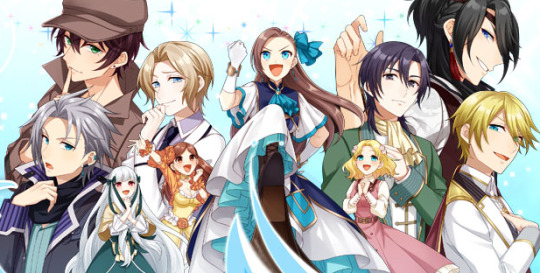
Who can say, maybe in the same way that Hamefura got a yuri anthology, there would be an otome game centering just the girls? That would make male japanese audiences the target demographic so I dunno how well that would sell to the japanese audiences though (since they might not like the idea of playing as a girl, and I'm not woke enough to be able to tell how much the female japanese audience would want to play that). The western side would love that, no doubt :DD. Like I keep saying, there was some negative reactions from JP fans about the lack of female love interests in the game for Katarina, but it didn't seem big enough for Otomate or Satoru Yamaguchi to do anything about.
I would not deny that the yuri side of the harem is very much well appreciated by the japanese audience, though maybe not as much as the love from the western side, but since hamefura is marketed as a shoujo series first and foremost so the decision to exclude them doesn't seem surprising. The yuri side is well loved too, but like you said, the hamefura market is mainly straight women qwq. I've heard that Otomate barely does any games with capture targets for both genders at all, and since hamefura is still a small series even considering its high LN sales, they maybe probably weren't confident in experimenting yet since it's still considered a niche imo.
Like the game isn't even subtle at all, the three girls are supporting cast in the game hkdhdkjs, from the simple and statis forward facing sprites whose only hands move, to their size on the boxart. I know most people would rather have the girls as capture targets than the two new guys, but I wanna give Silva and Rozy some credit, the ninswitch game has to provide new and unique options, since without them it'd just be the novels but turned into a game. They should have opted to have 4 boys, 3 girls and 2 new boys as options rather than cutting out the two boys entirely like what I've seen people say they wanted.
I'm sorry to hear that you wont be interested in picking up the game, even with the GeoKata moments. If it makes you feel better, I honestly don't even know if we're getting an actual ending in this game. Lot's of cute moments for sure, but I kinda feel like the endings are conclusive like the hamefura StoryMe game (except for maybe Silva and Rozy). We'd lose some good moments with the girls, but I hope maybe you can find peace in knowing that the game might not have a conclusive ending, maybe qwq.
Other than that, I've seen people make proposals about fan-made projects where it focuses on Katarina and the 3 girls, so if ever those proposals become real projects, that would be something to look forward to!! :DD
Thank you for the ask! qwq
#mh ask#hamefura#my next life as a villainess#hamefura pirates#hamefira kaizoku#bakarina#destruction flag otome#i'm depressed i didnt know how to respond to this except oof same#i'm so sorry anon hgsjhdgdjhsghdsfg
23 notes
·
View notes
Text
Tropes to Avoid: Exotic Brown Man
As I finish up various otomes that I will post for review I think in the meantime I will be doing a tropes to avoid series. Ideally I’ll be posting something every day, but it’s not a guarantee! So first I’d like to start with a very common stereotype that I see in the yumejo, otome and joseimuke sphere regarding brown characters.
So for those who aren’t incredibly acquainted with this trope/stereotype. Many stories will commonly have a brown character involved as a route in otome games, or a highly sought after character in mobile games. This character almost always garners a pretty dedicated fanbase, so you’ll almost never see a situation where they’ll end up unpopular. But there are a couple of very very cookie cutter and often problematic tropes that plague them.
1. They are usually from “an exotic country.” Commonly they will be highly implied to be arab, or their country will be a fictional one in the middle east. For why they came to Japan the common workaround is that they are either an exchange student or one of their parents are japanese.
This is not a problem in of itself. because the act of having a brown character is a nice addition to most media. But the issue comes in with the fact that developers never seem to think about where exactly they want this character to be from. The fictional region bit will be touched on later, but I don’t think it’s too much to ask to put that they’re from a very specific country in their biography. They especially have no excuse when there are other characters who have a bunch of attention put into where they came from, how they speak in relation to their place of birth or otherwise. It comes off incredibly lazy.
2. When from a fictional country, they end up being part of royalty or high class. Commonly a prince or some other noble title.
Again, not an issue in a vacuum. But when you compound this with the fact that they don’t exactly have a solidified place in regards to where their from it becomes problematic. The way the greater narrative will typically characterize this prince is that he’s exotic and eccentric. Not used to the customs of a new country, wearing “foreign” clothes that many of the other characters don’t understand. And also not having a good grasp of Japanese that is commonly played up for laughs or as a personality trait.
This is incredibly othering, because there are times it will get to a point where said prince doesn’t exactly feel like a real person. How do you expect others to grow attached to him if his main traits combine in such a way that he’s an enigma to everyone around him? How will you showcase him having major emotions or development without making it seem cheap or unrelatable? Well the answer brings me to my next trope.
3. He’s either happy go lucky, or stoic.
Despite being a foreign entity, you of course still want your audience to be invested in this character. But it seems like to get around their lack of effort in terms of characterization, they will enforce one of two traits upon him.
First is the happy go lucky type. This character will happily introduce himself to other standoffish characters. Paying no mind to his foreign origins he’ll be anybody’s friend. This type of characterization means that when facing emotional moments, your audience may be caught off guard because until then all you’ve done is see him smile.
The best case scenario is that you begin to see a lot more substance under his positive demeanor and thus become attached to him. In practice, the writing will rarely be good enough to work that way. Writers seem to very commonly have trouble with their happy go lucky types displaying anything but positivity and thus fail at these critical emotional moments. Thus you’re left with a character that doesn’t have anything to him other than he’s just...Kinda weird. That’s it.
The other route commonly taken is that he is stoic. This is actually much easier to see why its an issue straight on its face. The stoic brown man is commonly viewed as scary, is never portrayed with a proper smile in casual settings and seems very uptight. He does not speak about himself unless asked, and comes off as cold to everyone unless they get to know him. In terms of physicality, he’s portrayed as more muscular than the average person, and thus viewed as more intimidating.
“So brown characters just can’t be stoic?” Of course they can, but there’s a delicate balance that must be maintained when characterizing them that many writers do not care to even glance at. These characters very typically don’t have as many moments where they’re shown to be caring individuals compared to their lighter skinned counterparts. Or when they are, the other characters reactions to their softer side still has a racial undertone to it.
So then, what’s the appeal?
4. This character gets sexualized. A lot.
This is my biggest pet peeve. With games that feature majority men, you’re going to expect that all of them are designed with the idea that they’re attractive individuals that women want to gawk at. This is not an issue, but for some reason the brown character is commonly a target of sexualization that other characters do not receive or just doesn’t make sense.
Frequently portrayed with no shirt or little clothes on. Aspects of his cultural garb being used in such a way that you’re staring more at his abs or his chest. Perhaps touchy feely in an abnormal way. Sexually aggressive compared to other characters.
Again, these things would be fine in a vacuum. But the problem is this will happen disproportionately to the most of the time sole brown character of the series. And I am of the opinion that a lot of the time when we create fiction, it is formed from our opinions in the real world. So you have to ask yourself what the writers and developers think of people with darker skin if this is the standard.
I think it’s not too much to ask for people to step it up, and do some actual research or at least put in a bit more effort. Especially in otome games where we’re expected to consider dating a man like this.
13 notes
·
View notes
Note
I hate how there's so many on MCL fandom that basically snob Sweet Elite. Like I asked around those people about how many episodes they played and most of them just played the intro or the first ep and I'm like ??? It seems like the fandom forgot how MCL started. It makes me think they would also snob MCL if came out now.
Well, there are several factors to consider.
Firstly, people were younger when they started playing HSL, many would probably find the game too childish now, and that’s why they are also not interested in Sweet Elite which has a rating of 14 years old I think. There’s nothing to blame if this is the reason, people grow and tastes change, that’s normal. And the fact that all otome games are shifting their target audience to older people, young adults in their mid 20s in primis, makes me wonder how long Sweet Elite will be able to survive in a market where they are missing the paying costumers to cater for the younger ones who, in vast majority, will play for free. I know they said they will never up the rating and want to stay consistent, but if it’s a matter of survival they shouldn’t feel ashamed to reconsider. It’s not like they are experienced game developers, the first time doing anything you usually learn by trial and error.
Another thing to consider is that you can clearly see the influence that MCL had on Sweet Elite, and some people may feel put off by it. Like… studious student body president and rebel rocker who can’t stand each other and fight all the time but deep down also begrudgingly respect each other but will never admit it? 🙄 I wonder what that reminds me of… and then the high school setting, the AP system, the LoM that is basically the same but here is called Infinity meter… it’s not a critique, lots of new games get inspiration from more successful ones, even A6 is veeeeeery similar to WTNC. But, again, some people may have found it annoying at first and never continued playing.
And then there was the unfortunate team break up debacle and washing their dirty linens in public. I admit I followed what happened because I’m a terrible person who sees drama and has to check what that’s about. I never discussed it publicly because it’s none of my business, it’s none of the players’ business actually, and I hate this cancel trend that exists on tumblr. I play the game because I enjoy it, but I’ve seen lots of people dropping it or not wanting anything to do with it because of what happened. Personally, I saw who started first with the shading and the butt-hurt comments when that tumblr ranking list was published, and I also saw both parties’ motivations, however I think none of us is in the position to judge anyone there and these things should be left to the people involved.
And finally the art. I know people who hated the previous art and people who hate the new one, and I also saw people loving either one of the two or both, so it’s not like the situation changed much in that aspect. I think that once they find their stability things will improve, because the real problem is one: the timeline. At the moment there are sooooo many games around, competition is strong, that even if the games are good, if they don’t offer consistent updates and content they will be forgotten, this is the sad truth. Once upon a time, MCL was able to survive by releasing one episode every three months, they could because there weren’t that many games, especially in western countries. But now? This is not sustainable anymore, companies won’t survive this way when there are dozen others who release episodes and events all the time.
This is either a hobby, to do out of passion when one has time knowing that it will never make money, or a full time job. But what do I know, I can only speak as a long-time otome player who has seen the market change drastically in the past 10 years, I’m not into the gaming business myself, so maybe all these considerations are completely wrong.
33 notes
·
View notes
Text
#14: A Proper Introduction!
Hey, everyone! I know I haven’t written anything for a hot minute, but life has been a bit crazy lately, so I haven’t had as much time for gaming as I’d like. I was given a very sudden promotion at work, and said promotion included a literal mountain of new responsibilities, so most days I’m too exhausted to even do anything but binge watch YouTube and feel sorry for myself.
But I have no intentions of abandoning this blog - in fact, I finally got over this slump and started playing a new game last night! The next game I’ll be discussing is Bakumatsu Kourinden ONI - the direct sequel to Kishin Kourinden ONI, which I (somewhat sloppily) babbled about earlier this year. Kishin was a great, if somehow by-the-numbers JRPG, so I’m looking forward to experiencing what Bakumatsu has to offer. Read on below!

Fun fact! The ONI series started on the original Gameboy, and only made the move to home consoles after four games. I plan on covering those titles as well, as I have always harbored a great love for stories set in ancient Japan. As a student of the Japanese language, I spent a lot of time with old texts, so to have these stories reproduced, even if in a medium that most disregard as inferior, has been incredibly delightful. I am thriving!
As for my background, I started playing JRPGS shortly after I turned 10. My first was Albert Odyssey for the Sega Saturn. To be honest, I don’t remember much about it. I would learn later in life that it was localized by Working Designs, a somewhat infamous company whose works would later be criticized by gamers who felt that they went too far in disregarding the original texts in favor of humor, but as a kid in America, I didn’t know any better.
My most vivid memory of Albert Odyssey was how colorful it was - before, I had mainly played games developed in America, and they, as a whole, favored a more natural color palette in comparison to Japanese ones, so it felt very fresh to my eyes. Like a lot of nerds growing up, I didn’t exactly fit in, so seeing the cast tease and support each other lifted my spirits. They felt like personal friends.

I also loved the villains. If I remember correctly, there were quite a few female ones. I know not every gay man is attracted to powerful women, but I certainly was, so seeing women embrace being unabashedly evil thrilled me. I still root for the ladies, especially the evil ones, to this very day.
Albert Odyssey had a very orthodox gameplay system, but something about it hooked me immediately. My older brother was always a pro at anything that required hand-eye coordination, so he loved boasting how he could beat me at “any game”, but he wound up frustrated at Albert Odyssey very early on. He couldn’t figure out the puzzles; he didn’t understand why he couldn’t button-mash through every fight, and he was especially irritated by how slow-paced turn-based battle systems were.
I loved how RPGs, generally speaking, were not competitive games - rather, they were more of an experience, and one that was meant to be explored alone. They were the perfect fit for an introverted dork like me - an entire genre, spanning hundreds of titles, that I could freely enjoy without the presence of my overbearing, hyper-competitive brother. When I started this blog, I had a vision in mind of extensively covering obscure, Japan-only RPGs, but in time, this grew to encompass another genre I fell in love with: otome games. These are generally visual novels primarily targeted to a female audience, but for whatever reason, I fell hard for them. I love dramatic, character driven RPGs more than any other kind, so looking back, it seems only natural I’d be drawn to games of this nature.

As for how I started learning Japanese, I was exposed to Japanese music when I was around 13 (I’m 31 now!), and fell in love with the way the language sounded. I begged and pleaded with my mom to buy me a basic grammar, and started learning by myself a few weeks later. I managed to get farther than most in my self-studies, as I was determined to be able to understand the lyrics of the songs I loved without relying on others: in the process, I developed a true passion for the language itself, which lead me to studying it in-depth once I went on to college.
Somewhere along the line, I discovered Japan’s rich literary history, and fell hard for the Heian era - and in a strange mirror to my younger days, I’ve recently started studying classical Japanese in order to, again, understand the poems and stories without the help of another. It has, so far, been an incredibly rewarding experience. My lifelong dream is to become a literary translator, but for now, I manage a Starbucks department in a grocery store. Day jobs, right?

We stan Ono no Komachi in this house.
I’ve ranted long enough, so if anyone reads this, I hope you find yourself well! And please feel free to give me a follow! I’m very new to blogging, so learning how to grow an audience is something that I’m kind of puzzled about. If you’ve read this far, please enjoy this picture of me with my best friend’s adorable kitty. He has no eyes. We must stan.

#gaymer#retro gaming#retro game review#introduction#super nintendo#super famicom#oni#bakumatsu kourinden oni#otome games#otome
1 note
·
View note
Text
The Process: Research
Ever wanted to make something, but didn’t know where to start? We too. In this second installment of The Process, we’ve finished forming our idea and now it’s time to inform it.
2. Research
Mind you, this isn’t a “step two” per se. Here’s the big kicker on what we soon discovered about this part of development:
Research is an active, ongoing process, whose goals change throughout pre- to post-production.
We may have created the idea of Primrose Path but our research didn’t stop at the end of pre-production, as if to say we’ve got everything we need and now it’s time to dive into making it. During production, we still had questions. Research is the only reason that, if you stopped us on the side of the street, the topics of future biomaterials and methods, dynamic UI design, and historic architectural eras could all pop up in the same conversation.
And all of that is valuable information to us, because researching is relevant in every area of the process! But what kind of information did we look for?
Our five categories are Community Canvassing, Story & Character Development, Team Management, Game Design, and Marketing.
Let’s break it down:
A. Community Canvassing
Identifying and learning our target audience.
Identify personal wants from our game.
We have to stop and think: what kind of game do we want to play? If you want something, chances are, there’s a group of people out there who want the same thing. They are our audience.
Identify the type of media and genres relevant to our game.
Our video game is a visual novel, and its market genres are predominantly adult, drama, and romance. Because the medium of visual novels originated and is popular in Japan, we use the term otome (Japanese for “maiden” or “girl”) or otoge (portmanteau of “otome” and “game”) in our genre list. So, our game is an adult, drama, romance, otome—or focused on a female main character who deals with a cast of potential male partners.
Case any census data and statistics on target and related communities’ research blogs.
This one was important to us because we like considering quantifiable data that gives us the bigger picture. Statistics blogs and databases helped us get a clearer view of different demographic subsets of the visual novel community. It’s also important that we read material about sister media like the general interactive fiction community, as both deal with reader input and resultant story-branching.
Inquire fans in those genres for game recommendations and any opinions.
Community hubs are a click away. We connected with others via forums like Reddit and instant messenger servers like Discord that specifically revolve around fans and game developers of the visual novel medium.
Read game reviews in those genres by other fans and critics.
The most interesting thing for us when we read these reviews is not so much what someone did or didn’t like, but what aspects of the game they focused on, and what other topics they decided to connect to their original answer. You may be surprised how people decide to expand on their answer and where tangents lead, which is very telling, valuable associations.
Connect with other developers for support and networking.
The Western visual novel community is a small community, but commercial success is not confined to said community. Building a rapport with other hardworking devs is important, as it follows us in such a small space—for better or worse. There’s a lot to learn from the wider indie development community, too.
B. Story & Character Development
Creating an organic experience.
Real-world parallels to inspire for or reference in game direction.
Whether we take a trip to the city with a camera and sketchbook, rent and buy books from libraries and bookstores, or visit Google Maps in satellite view, we are pulling up everything we need to inform our game’s locations, people, and events.
Observe and converse with people.
The behaviors, quirks, appearances, opinions, and feelings of people are abundant, and it’s not until we observe and sometimes familiarize ourselves with others that we catch some of the concerted expressions that create a nuanced individual.
Interacting with others is first-hand experience, and listening to or reading others’ experiences is second-hand. If we can't write from first or second-hand experience, we must inform ourselves with other sources, as it’s crucial in writing characters with whom we may not directly or easily identify. We often defer to interviews and documentaries to start.
Psychology and sociology research.
Sometimes reading from experts about general trends and triggers of the human condition makes it easier for us to understand, verify, and better portray things like addictions, behavioral disorders and mental illnesses, fetishes, and cultural stigmas for our character development and world-building. Though this isn’t limited to negative or abnormal things we cannot identify. It can also be in what ways the values of a person or society evolve, or how players interact with video game avatars!
Read and deconstruct critically-acclaimed novels in our genres
It’s understood that if people want to become better writers, they have to become better readers. Being able to settle down with some traditionally-published, well-received books relevant to our interests will help us build on our knowledge of suitable writing conventions, as well as analyzing broader narrative elements, like plot pacing. We even have a list of writing resources saved to help us break it all down!
C. Team Management
Standardizing ways to increase workflow efficiency.
Pipeline development.
Know a general end-date to keep in mind for the finished product. Setting a scope for our project and a timeline for production challenges us to keep on task as we work towards that date. We’ve set ours up by month and refer to that document for phase estimation.
Time management, task delegation, task tracking, and work logs.
Whether your team is me, myself, and I, or made of employees and contractors, it’s important to stay synchronized and keep record of that progress. Quiet Days has our own GitScrum board to help us with assigning tasks, timing how long a task takes us versus the amount of time we expected it to take, and streamlining the process from start to finish. It also keeps track of percentage of overall project completion and key performance indicators (KIP), or the metrics of a user’s personal contribution and work ethic over a period of time. There are a plethora of other task management sites and apps available to use too.
Style guides to standardize writing and art.
Between the two of us at Quiet Days, we both work on the 2D art and writing, and we both default to different visual and writing styles. So, we’ve set up and continue to add to our respective guides, keeping the art style and narration and character portrayals consistent. This is especially helpful should we take up other artists or writers, so that they can easily assimilate into our workflow.
Account delegation for social media and company correspondence.
Understanding who does what for cohesion under a company brand is important for its image. We share all accounts under the company name, so technically both of us have access, which works well for our team of two. It’s early, but so far “delegation” seems to have taken on a natural division between Coda and Elm—the former taking to micro-blogging, and the latter to streaming and forum correspondence. While this dynamic may change in the future, we both refer back to each other under the Quiet Days brand.
Potential for contracting help.
We’ve considered that there may be a time in production where a helping hand is needed. Additional considerations like the freelancing market and pricing are kept in mind for the future.
D. Game design
Scrutinizing game elements from a developer’s lens.
Consider for which platform to design.
PC? Mobile? Console? Cross-platform? While we are primarily designing our game to be played on PC, should we want to capitalize on popular handheld consoles like the Nintendo Switch, for example, things like game engines and builds, game optimization, resolution, encryption, touch capabilities, and content guidelines for their private company platform all need to be considered. These things change between platforms.
Consider designing globally.
There are people different from us who would like to enjoy our game too. We consider the user experience (UX) for things like the possibility of game translations and using fonts types that read well for different language characters like Chinese or Russian. We also consider how to customize the experience to accommodate for players with different cognitive abilities, which falls under accessibility features.
Play what’s commercially un/successful and community-recommended.
We can learn a lot from both good and bad game design, and what the community mostly consumes. We engage with these games and take notes on graphics, accessibility features, user interface (UI) designs, game mechanics, soundtracks, and overall presentation and aesthetic. What did we like and what would we have preferred?
Stay updated on game design development tips from industry heads
There are people who have been doing it much longer than we have, and a number of them are setting industry standards. We can learn a thing or two in how they handle a problem and find solutions.
E. Marketing
Methods for optimizing outreach and return of investment.
Social media strategies for engaging and involving our audience.
We’ve laid the groundwork for character accounts on social media to launch as a way for our audience to interact with characters from our game. While role-playing is a fun marketing and meta world-building device, we’re exploring other cool avenues like exploitable images and audience challenges to drum up future participation.
Types of advertising and promotional materials.
There may come a time when word-of-mouth may not be enough. Would we consider purchasing ad space on different sites for greater visibility, or spend money on “promoting” features on social media? Would we commission or create and sell promotional merchandising for our audience?
Crowdfunding platforms and prospects.
Popular ones like Patreon, Kickstarter, and Indiegogo all have their draws and their drawbacks for creators and supporters alike. For what expenses would we crowdfund? What additional rewards would we provide for the financial support, if any? Do we want financial support for our project, or continual financial support as a company creating content? Some developers don’t actually use these platforms to request funding, but as another way of advertising their game. Would we do that?
Cross-exposure with other devs.
Interviews, public events, and collaborations with other game developers is a win-win situation with everyone involved. We want to be able to not just network, but allow each other to introduce our products and skills to a greater audience, creating and sharing a unique, dedicated fanbase in the overlap.
The Takeaway
At the time of this post, we’re still in the production phase, so some of this information isn’t applicable right now, but no knowledge is wasted: these things will always be handy to know and consider for later. We’re making our decisions in lieu of—and even despite some of—our research, in order to create a game that we’ll love and hope others will too. It’s important that as a game developer, you too keep yourself informed!
Speaking of ongoing research, Western otome is a largely indie market with many small, tenacious teams and hardly any corporate studios. If you are a Western otome developer, please contact us! We’d love to interview you in a Q&A, get your input on your process, and feature your story on our blog!
#devjournal#gamedev#game development#indie otome#indie game#theprocess#process#visual novel#journal#otome#otome game#diary#indiedev#personal#team management#story development#character development
9 notes
·
View notes
Text
7 Deadly Sins <Beemoov edition>
So reminiscent of the art day which was my fav episode and because I won't be playing this game again as I don't support companies that want to eat money for breakfast by creating bad relationships with their clients, I wanna do the 7 Deadly Sins <Beemoov edition> because this Q&A got me angrier than it should
1. Greed - Let's start with the obvious being that you're literally trying to squeeze our pockets and you've surprased the limit of "hey I'm a company and I need money to function" by long. I get that you need more money because you're expanding but there are so many more ways of doing that by showing you care about the people that give you money and I'll just give u some examples
-Increasing the prices of AP and $, this will make the fandom moan a little but hey it doesnt affect the overall game experience and it still makes it optional as the previous system spent less and people were able to accumulate more APs.
-Maybe even sell exclusive outfits or items? Like the outfits you give in conventions. But instead of AP or $ they would cost real money.
-Creating more merch, like people would have loved more plushies or little stuff like this is what people would like to spent their money on.
-More events. I know you're working on them but yo this is a very profitable way and people love exclusive items.
2. Envy - You're probably envious that your game isn't doing as well as the previous one and this makes you frustrated. Ans your answers were very passive-aggressive because clearly you don't like it. You will probably also be envious on the fact that better games will be developed with a team that isn't so desperate to make money and has morals in order to satisfy the people before making such a drastic decision that can affect the enjoyment of the game. Oh and also, I guess you could also say that the fandom is envious on the people who can afford to spend so much money monthly on your stupid game because a lot of us are just students that try to be frugal but I guess your target audience doesn't matter, does it?
3. Gluttony - Oh how you love consuming us and how hungry you are for money. Would you like some eggs with your dirty money, Beemoov? Binging like this might actually kill you and your company, what's too much is too much. And when your fandom addresses these issues you still don't stop.
4. Wrath - I think all those angry reactions on your facebook posts say everything about this. Both parties are experiencing frustration and anger but the difference is that people are also disappointed. You're so frustrated that your fandom hates something you did. But I think the biggest wrath comes from the fandom itself, I think anger is the perfect sentiment to describe how people are feeling about your company and ethics, your marketing team, your system and your stupid Q&A that you might as well call Q&And fuc you.
5. Pride - You're too prideful to admit that you screwed up and too stubborn to make a change. You "stand by your AP system" because that's your company and you're a big boy and can do whatever you want. Honestly you're so childish Beemoov it's ridiculous. You basically ignore all of our complaints or just beat around the bush to blame it on "communication". It's not about communication, we made it really clear how we feel yet you still don't get it.
6. Sloth - Took you long enough, almost 3-4 months to answer us and yet you still didn't do it properly. You basically just said "they'll get used to it" and then when no one did you were like oh sh*t gotta answer these questions now ughhhhh. Also it's funny how most of your answers are just "No.". Nothing else. Just no.
7. Lust - I'll just interpret this with, Beemoov getting turned on when they see another player that wants to get into the game and giving them the money they so don't deserve, essentially losing their otome virginity on this shit game (who isn't as interesting when you gotta pay more now and dont evem have your fav characters anymore) and giving their money to a company who only screws the fandom over.
This is all I had to say woop, some things are a little over exaggerated, but hey it comes from the truth after all.
65 notes
·
View notes